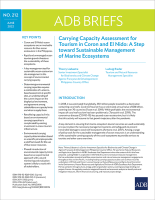
Frontier technologies such as the Internet of Things, artificial intelligence, and blockchain are expected to become commercial in the future and have the potential to transform climate actions. Photo credit: iStock/Parradee Kietsirikul.
Riding the waves of innovations can help leapfrog Paris pathways.
Digital technologies have been widely recognized for their catalytic role to accelerate climate actions. In Southeast Asia and many parts of the world, businesses and governments are unleashing the power of digitalization to transform their approaches to climate challenges.
While the possibilities of digital technologies are vast, developing economies in the region first need to create an enabling environment to realize the full potential of these solutions. Harnessing the benefits of these technologies requires investments in digital infrastructure and advanced digital literacy, safeguards for privacy and data security, as well as private sector collaboration to ensure the seamless interoperability of digital products.
A holistic view of the landscape of technologies, along with the necessary considerations in selecting solutions to achieve development objectives, can help Southeast Asian countries assess and evaluate the usefulness of these tools for their climate agenda in their unique context.
Heat is on to limit warming to 1.5°C
At the recently concluded COP27 held in Sharm El Sheikh, Egypt, there was a broad agreement “to increase climate ambition in national contributions to respond to the climate emergency.” As temperatures have now risen at least 1.2°C since the preindustrial era, United Nations Secretary General Antonio Guterres issued a stark warning, “we are on a highway to climate hell with our foot still on the accelerator.” With many world leaders and stakeholders echoing this sentiment, the push for stronger measures to slash emissions calls for wide ranging solutions, including the deployment of digital technologies.
In Southeast Asia and the wider Asia-Pacific region, an Asian Development Bank (ADB) publication notes that frontier technologies such as the Internet of Things (IoT), artificial intelligence (AI), and blockchain are expected to become commercial in the future and have the potential to transform climate actions.
While there has been widespread digital transformation across Southeast Asia during the pandemic, barriers to adopting and scaling up tech solutions remain. Among the challenges are financial constraints, lack of technical skills, privacy and security concerns, and the fragmented landscape of IoT and smart systems, which constrain their interoperability. The ADB publication also emphasizes that selection of digital technologies requires careful consideration of the larger development objectives weighed against cost effectiveness and limitations and the local circumstances.
Tackling barriers to tap into tech’s transformative power
The rapid evolution of technologies has prompted countries in Southeast Asia to undertake measures in boosting the supply of digital skills to remain competitive in the modern era. In Singapore, its national skills strategy called SkillsFuture movement is building the foundation for a highly skilled, productive, and innovative economy. In Malaysia, public-private partnerships are helping close the skills gap to realize the Malaysia 5.0 agenda. Inspired by Japan’s Society 5.0, the agenda seeks to transform the country into a digital nation with Industry 4.0 technologies integrated at every level of its society and a digitally focused national education system.
Given the immense climate financing needs of the region, ADB provides funding support for the diffusion of technologies to its developing member countries. Last year, ADB expanded its climate finance ambition to $100 billion from 2019 to 2030 to realize its climate agenda, which includes channeling investments into climate-friendly technologies. Its venture platform, ADB Ventures, is partnering with tech startups and innovators that are driving decarbonization efforts in the region.
On IoT interoperability, major tech companies such as Amazon, Apple, Google, and the Zigbee Alliance have joined forces to enable the compatibility of smart home products with the aim of delivering a seamless user experience. A better-connected ecosystem can boost the IoT market for smart home technologies, such as intelligent thermostats, smart light switches, automated energy management systems, which are designed to address the growing need for low-carbon solutions.
Climate solutions from commodities to carbon markets
Across Southeast Asia, applications of digital technologies in various sectors are bolstering climate-related measures. For instance, drones are being used in Indonesia for the sustainable management of oil palm plantations and prevention of land and forest fires. In the Philippines, Grab partnered with the World Bank to develop an open-source platform for using anonymized GPS data generated by more than 500,000 Grab drivers to analyze traffic congestion peak patterns and travel time, enabling better traffic flow management which helps avoid unnecessary emissions.
For Asian digital powerhouses like Japan, the Republic of Korea, and Singapore, IoT systems and AI are being used for intelligent buildings and smart city development as part of their climate and sustainable development strategies. These countries also seek to mitigate their climate impacts using digital twin technology, a virtual representation of a real-world physical element to collect information and data via tools like sensors and drones which are then combined with advanced analytics, machine learning, and AI. Recently, a “virtual clone” or digital twin of the entire Singapore was created to have a single, accurate, consistent, and reliable model for capturing real-time data. This first country-scale digital twin will allow Singapore to better plan for infrastructure development, enhance management of wastes, energy, and water resources, and optimize the performance of its built environment, thereby helping the country’s efforts in reducing its carbon footprint.
Another area being transformed by new technologies is construction, which contributes to 11% of all global greenhouse gas (GHG) emissions. Skycatch, an ADB-supported technology firm with operations in Indonesia, the Philippines, and Thailand, is helping improve construction planning and operational efficiency significantly through three-dimensional drone data capture, processing, visualization, and analysis, which cut costs and lead times and reduce environmental waste and carbon emissions.
As countries design their carbon pricing initiatives, the digital revolution must be harnessed for monitoring, reporting, and verification (MRV) systems to streamline data collection and verification of GHG emissions inventories, which will enable real-time generation of carbon credits. In its newly released publication, the World Bank recognizes that such undertaking is complex and costly to implement at this stage but expects digital MRV to be a gamechanger for building robust carbon markets, especially in low-income countries with inadequate capacities to conduct MRV.
Evidently, the many use cases of digital technologies for climate action show the potential for expanding their application in Southeast Asian countries and across the globe to combat climate change. As the window of opportunity to keep the world from the 1.5°C danger line is closing rapidly, it is time to fully tap into digitalization to drive decarbonization fast enough while steering the planet onto a sustainable pathway, instead of a “highway to climate hell.”

